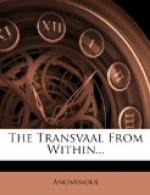It is not necessary to refer in great detail to the settlement In effect it was that the Boers gained nearly all that they required, but not until the haggling and threatening had robbed concessions of all appearance of grace and justice. The natives were referred to in the conventional spirit. The unfortunate loyalists were left to take care of themselves. The men who had entered the Transvaal, and invested their capital and expended their energies there upon the most positive and sacred assurances of the British Government that the Queen’s authority would never be withdrawn,—assurances given in public by the Conservative Government and confirmed by Mr. Gladstone’s Government, assurances published by Sir Bartle Frere and Sir Garnet Wolseley, who said that ’as long as the sun would shine the British flag would fly over the Transvaal,’—were heartlessly abandoned, their protests were unheeded, the compensation allotted to them, namely, L1,400,000, was amended by the elimination of the million, their representations to Mr. Gladstone’s Government were finally left unanswered—unless it be that the sneering reference made by that right honourable gentleman in the House of Commons to ‘interested contractors and landjobbers’ may be considered an adequate answer to a protest as moderate, as able, as truthful, and as necessary as Mr. Gladstone’s remark was the reverse. In very truth, the position in which the British Premier had placed himself through his intemperate speeches in the Midlothian campaign, and his subsequent ‘explaining away,’ was an extremely unpleasant one. In Opposition Mr. Gladstone had denounced the annexation and demanded a repeal. On accession to power he adopted the policy of his predecessors, and affirmed that the annexation could never be revoked. On June 8, 1880, he had written to this effect to Messrs. Kruger and Joubert, the Transvaal deputation. Later on, in answer to an appeal that he should allay the apprehensions of the loyalists, who feared the results of the Boer agitation, he referred them to this very letter as




